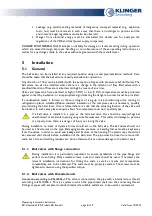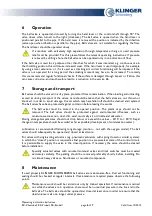
Operating instruction ball valves
RK-Chemoball, RK-Proball, RK-Ecoball
page
4
of
7
Valid from 12/2013
•
Leakage (e.g. spindle sealing material) of dangerous conveyed material (e.g. explosive,
toxic, hot) must be removed in such a way that there is no danger to persons and the
environment. Legal regulations must also be observed.
•
Danger from electrical energy must be eliminated (for details see, for example, the
regulations of the VDE and local power supply companies).
KLINGER SCHÖNEBERG GmbH accepts no liability for damage or faults occurring during operation
which are caused through improper handling or non-observance of these operating instructions, as
well as for any changes made to the valves without agreement with the manufacturer.
5
Installation
5.1
General
The ball valves can be installed at any required position using normal pipe installation methods. Care
should be taken that the ball valves are easily accessible for operation.
Any direction of flow can be installed (with the exception of types with pressure relief drill holes). The
ball valves can also be installed where there is a change in the direction of flow. Ball valves with a
specified direction of flow are marked accordingly by means of an arrow.
Valves and pipes which are operated at high (> 50°C) or low (< 0°C) temperatures must be protected
against contact by insulation, or an appropriate sign indicating the danger on contact must be provided.
If condensation water is formed or there is danger of icing up in air-conditioning units, cooling or
refrigeration plants, suitable diffusion-resistant insulation of the complete valve is necessary, possibly
also including the hand lever. If ice is formed there is a risk that the actuating function of the valve will
be blocked. In such cases please enquire about “low temperature version” special types.
If a ball valve is installed in a pipe as the terminal valve this should be secured against
unauthorised or accidental opening using suitable measures. This will avoid damage to persons
or property since there is a danger of injury on closing the valve.
During installation no static or dynamic forces should act on the ball valve. The ball valves should not
be used as a fixed point on the pipe. Damaging tensile, pressure or bending forces must be kept away
from the valves, in order to avoid seal leakage and fracture of the housing. The plastic caps should not
be removed until shortly before installation of the ball valve. The pipe must be rinsed to remove dirt,
scale, burr, zinc and welding residues etc, since otherwise this can cause damage to the ball or seals.
5.1.1. Ball valves with flange connection
During installation it is particularly important to ensure parallelism of the pipe flange and
perfect close fitting. Only suitable screws, nuts and seals should be used. If necessary the
relevant installation instructions for fitting the seals, as well as media and temperature
compatibility, are to be observed. The seals must be properly centred. The screws must be
tightened crosswise using the specified torque.
5.1.2. Ball valves with threaded ends
Connection according to EN 10226-1: The valve is connected to the pipe with a internal screw thread,
according to EN 10226-1. This is a system in which the pipe thread seals into the connecting thread.
Fittings or pipes with a tapered outside thread and a suitable sealant are to be used as counterpart.

























